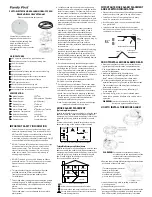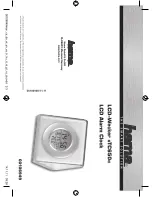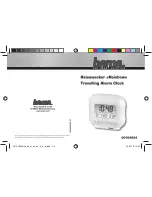
mission to the controller. The Common Circuit is also used to:
Ø
Control Sounder and Relay bases via the ‘Functional Base Interface Circuit’
from controller commands.
Ø
Control the operation of the Remote LED via the ‘Remote LED Circuit’ from con-
troller commands.
2.5
WIRING
Loop cabling is connected to base terminals L (-ve) and L1 (+ve). A drive is pro-
vided for a remote indicator connected between loop positive and terminal R. Ter-
minal L2 (analogue output) is for use with functional sounder and relay bases.
3.
MECHANICAL CONSTRUCTION
The major components of the detector are:
Ø
Body Assembly
Ø
Printed Circuit
Ø
Optical Chamber
Ø
Optical Chamber Cover
Ø
Thermistor
Ø
Light Pipe
Ø
Outer Cover
3.1
ASSEMBLY
The body assembly consists of a plastic moulding
which has four embedded detector contacts which
align with contacts in the base.The moulding incorpo-
rates securing features to retain the detector in the
base. The PCB is clipped to the body by four spring
contacts.These contacts act as a mechanical fixture
during assembly and provide electrical contact be-
tween the contacts and the PCB. The chamber cover
is clipped to the body over the optical chamber ensur-
ing the thermistor protrudes through the cover.The
light pipe is slotted into the chamber cover.Finally, the
outer cover is clipped to the body.
4.
TECHNICAL SPECIFICATION
4.1 MECHANICAL
Dimensions:
The overall dimensions are shown in
Fig.5 ( less base ).
Materials
Body,cover, and closure:
FR110 ‘BAYBLEND’ flame retardant.
Weight
Detector:
0.076kg
De Base:
0.14kg
4.2 ENVIRONMENTAL
Temperature
Operating:
-25
o
C to +70
o
C
Storage:
-40
o
C to +80
o
C
Relative Humidity:
95% ( non-condensing )
Shock:
Vibration:
EN54-5 and EN54-7
Impact:
Corrosion:
EN54-5 and EN54-7
The detectors comply with Lloyd’s Register Test Specification Number 1 (1996).
Environmental Category ENV5.
4.3
ELECTROMAGNETIC COMPATIBILITY
The detector complies with the following:
Ø
Product family standard EN50130-4 in respect of Conducted Disturbances, Radi-
ated Immunity, Electrostatic Discharge, Fast Transients and Slow High Energy;
Ø
EN61000-6-3 for Emissions.
4.4
ELECTRICAL CHARACTERISTICS
The following characteristics (Table 1) apply at 25
o
C and nominal supply voltage of
37.5V
unless otherwise specified.
Table 1: Electrical Characteristics
Characteristic
Min.
Typ.
Max.
Unit
Loop Voltage
20.0
-
40
V
Quiescent Current
-
275
305
µA
Alarm Current*
3
3.3
mA
* No remote indicator fitted
per la trasmissione alla centrale. Sul Circuito Comune è inoltre utilizzato:
Ø
Contollo delle basi acustiche e relè tramite ‘Circuito d'Interfaccia della Base
Funzionale’ dai comandi della centrale.
Ø
Controllo del funzionamento del LED Remoto tramite ‘Circuito LED Remoto’ dai
comandi della centrale.
2.5
COLLEGAMENTO
Il collegamento al loop è realizzato sui terminali base L (-ve) e L1 (+ve). Un aziona-
mento è fornito per un indicatore remoto collegato tra il positivo del loop ed il terminale
R. Il terminale L2 (uscita analogica) è utilizzato con le basi acustica funzionale e relè.
3.
COSTRUZIONE MECCANICA
I maggiori componenti del rilevatore sono:
Ø
Corpo Assemblato
Ø
Circuito Stampato
Ø
Camera Ottica
Ø
Coperchio Camera Ottica
Ø
Termistore
Ø
Condotto Ottico
Ø
Coperchio Esterno
3.1
ASSEMBLAGGIO
Il corpo assemblato è costituito da un stampo in materiale
plastico con quattro contatti inseriti nel rilevatore allineati
con i contatti della base. Lo stampaggio unisce e assicura il
mantenimento del rilevatore nella base. Il PCB è aggancia-
to al corpo tramite quattro contatti a molla. Questi contatti
fungono da fissaggio meccanico durante l'assemblaggio
stabilendo un contatto elettrico tra i contatti ed il PCB. Il co-
perchio della camera è agganciato al corpo sopra la came-
ra ottica assicurando il termistore il quale sporge attraverso
il coperchio. Il condotto ottico è composto da una scanala-
tura all'interno del coperchio della camera. Infine, il coper-
chio esterno è agganciato sul corpo.
4.
SPECIFICHE TECNICHE
4.1 MECCANICHE
Dimensioni:
Le dimensioni generali sono indicate in
Fig.5 (senza la base).
Materiali
Corpo,coperchio e chiusura:
FR110 ‘BAYBLEND’ ritardante fiamma.
Peso
Rilevatore
:
0,076 Kg
Rile Base:
0,14 Kg
4.2 CARATTERISTICHE AMBIENTALI
Temperatura
Funzionamento:
da -25 a +70
o
C
Stoccaggio:
da -40 a +80
o
C
Umidità relativa:
95% ( senza condensa )
Shock:
Vibrazione:
EN54-5 e EN54-7
Impatto:
Corrosione:
EN54-5 e EN54-7
I rilevatori sono conformi alla Specifica Numero 1 (1996) del Registro Test Lloyd’s.
Categoria Ambientale ENV5.
4.3
COMPATIBILITÀ ELETTROMAGNETICA
Il rilevatore è conforme a quanto segue:
Ø
famiglia di prodotto standard EN50130-4 rispetto alle Perturbazioni Dirette,
Immunità Irradiata, Scarica Elettrostatica, Transitori Rapidi e Alta Energia Lenta;
Ø
EN 61000-6-3 per le Emissioni.
4.4
CARATTERISTICHE ELETTRICHE
Le seguenti caratteristiche (Tabella 1) si applicano alla temperatura di 25
o
C e alla
tensione nominale di alimentazione di
37,5 V
salvo diverse specifiche.
Tabella 1: Caratteristiche elettriche
Caratteristica
Min.
Tip.
Mass.
Unità
Tensione Loop
20,0
-
40
V
Corrente a Riposo
-
275
305
µA
Corrente in Allarme*
3
3.3
mA
*Senza indicatore remoto
Sezione e vista superiore del rilevatore
FIG.4
Sectioned and Top View of the Detector
Dimensioni generali del rilevatore FC400PH
FIG.5
Overall Dimensions of FC400PH detector






















